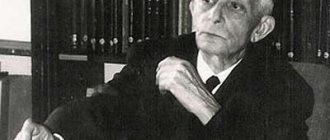The field of psychology includes disciplines with different approaches that have emerged over centuries of scientific development. One of them is the humanistic movement, which arose at the dawn of the 60s in the USA as an alternative to psychoanalysis and behaviorism, which occupied dominant positions at that time. A short and clear explanation of the humanistic approach is to work with the emotional, creative and moral aspects of a person.
The individual is considered as a complex and unique system with variable behavior endowed with free will. This contradicts the views of adherents of behaviorism and psychoanalysis, who generalize the interpretation of human behavior by impulses of the unconscious and equate the reflexes of people with animals.
What is humanistic psychology in simple words
Humanistic psychology, briefly and clearly characterized as focused on the characteristics and aspirations of the human personality, describes it as a unique structure whose exclusive property is self-actualization. According to this discipline, a person independently creates himself throughout his entire existence, which is why he cannot be considered complete at any specific point in time.
This branch of psychology is also called the 3rd force in relation to psychoanalysis and behaviorism.
She works with sublime manifestations of personality, which include:
- autonomy;
- Liberty;
- self-realization;
- moral principles;
- creation;
- personal growth;
- Love;
- responsibility;
- meaning of life;
- sound thinking;
- communication.
Interesting Facts
Let's look at some interesting facts about the humanistic movement.
- The ideas proposed by Maslow were criticized by the founder of psychoanalysis, S. Freud.
- Frankl invented the concept of “Sunday neurosis,” which characterizes the depressed psycho-emotional state that a person may experience at the end of the work week.
- Carl Rogers, one of the founders of the humanistic movement, planned to become a farmer in his youth.
- The school of positive psychology also belongs to the humanistic direction.
- Humanistic psychology relies on existentialism as its philosophical basis.
- This direction in psychology opposes the construction of psychological knowledge on the principle of natural sciences.
What does humanistic psychology study?
This scientific movement, of which popular positive psychology is one subtype, defines people as active independent subjects. According to this teaching, they differ from each other due to unique sets of qualities that, while ensuring human individuality, integrity and freedom of choice, do not interfere with the existence of society.
Humanistic psychology has a specific research process, one of the main differences of which is an individual approach. It can be briefly described as scientific work that focuses on the aspects of a person that make him unique. For a superficial understanding of therapy, it is enough to understand that one of its main tasks is to overcome possible alienation due to discrepancies between these aspects and the norms of society.
Supporters of the humanistic movement describe a person as an individual who makes choices independently, in accordance with his personal principles and assessment of the situation, and not as a result of receiving external impulses.
Humanistic psychology
The main subjects of research are:
- stages of personality degradation;
- mental health and harmony;
- need for a sense of security;
- basic physical and social needs;
- stages of development and success;
- self-esteem;
- giving life meaning;
- embodiment of oneself.
Personality congruence according to K. Rogers
K. Rogers considers the individual to be the center of a constantly changing world, which he calls phenomenal. These are not objects and objects, but human emotions and feelings. The body immediately after birth learns to perceive its environment. Over the years, he accumulates experience and habits. A person reacts not to reality, but to his perception of reality.
Rogers was a representative of the phenomenological school. Its main principles:
- independent choice of fate;
- the ability to understand a person only from his point of view;
- The pursuit of excellence.
Since a person makes his own choice, he determines his destiny. But you can understand him only from his position. It is necessary to understand the subjective perception of reality from the point of view of the individual. The third principle says that every person is good by nature. He always subconsciously strives for perfection.
The concept of reality in psychology is separate : it is an individual’s personal perceptions of the world. A person evaluates any experience in his own way. Some satisfy his needs and are therefore remembered as an experience. And others are discarded and are not realized.
Psychotherapy, according to Rogers, should help a person reveal his emotions and potential. He believes that a specialist should support the client through empathy. It is necessary to positively accept the individual and create an optimal atmosphere for him. The consultant must ensure that the client himself understands his problems.
This focus in work will help him rethink the situation and independently find a way out of it.
Basic provisions and tasks of science
The main theses of this area of mental health care were compiled in 1963 by James Bugental, Ph.D. and psychotherapist, who at that time served as the first president of the AHP - Association for Humanistic Psychology (in the original AHP - Association for Humanistic Psychology).
The postulates he formulated and individual statements of his colleagues remain relevant to this day and are key for this branch of psychology:
- It is impossible to describe a person by examining only his particular functions. The individual must be studied completely, since he, being a holistic being, exceeds the totality of the components of his personality.
- A person’s life is an indivisible flow of his being and becoming.
- Humans are creative and active creatures who can set intentions, think and act on them. It is important for them to be significant, to represent benefit, authority, and to express themselves creatively.
- Human existence is conditioned by the unique human environment.
- Individuals are open to the world by default. Their sense of the world and themselves in it is a basic psychological reality.
- People can be responsible and have freedom of choice.
- One’s own moral principles and meaning, which determine a person’s choice, to some extent free one from external determination.
- Statistics are not absolute truth. Because each person is unique, individual precedents are also useful for research.
- Awareness of oneself in relation to other individuals is part of human consciousness.
- A person has a need to endlessly realize himself and develop; the potential for this is inherent in human nature.
- Observation of animals cannot be used in the study of humans.
Subject of study
The basic subjects studied by humanistic psychology are the following:
- the uniqueness and originality of each individual person, who is in a constant process of self-creation, aware of his life calling;
- awareness of personal dignity;
- human needs in society;
- search and determination of the meaning of life;
- needs for protection and reliability;
- mature individuals who have reached the heights of self-improvement.
According to humanistic psychology, there is no conflict between the individual and society. On the contrary, a person is able to experience the fullness of life only through its recognition by society.
Founders and followers of the direction
One of the fathers of the humanistic approach is Abraham Maslow, best known for creating a pyramid-shaped hierarchy of human needs. The idea of human integrity also belongs to Maslow, who viewed people as initially positive beings with a desire for development, and psychology as primarily an auxiliary means in achieving the level they need.
In his work, Maslow was guided by considerations of existentialism, which are manifested to one degree or another in all facets of his teaching.
Psychologist-neurologist Viktor Frankl from Austria, who created logotherapy, brought the ideas of his methodology to humanistic psychology. Logotherapy names the search and evaluation of life meanings as what motivates a person. According to Frankl's therapy, during this search a person develops and realizes himself.
The author of the concept of personality traits, psychotherapist Gordon Allport, described a person as a self-developing personality, open to interpersonal and social interaction. Having changed the direction of research in favor of healthy people, Allport cited the theses and tasks of the humanistic study of the integral personality as an alternative to the methods of psychoanalysis and behaviorism.
According to the psychologist, collecting and describing facts are insufficient survey measures; in addition, they need to be connected with each other and interpreted in a systematic manner. Allport also disputed the explanation of interaction as coming into harmony with the environment, since he did not consider development as adaptation to it.
Experienced psychotherapist Carl Rogers, who identified the “self-concept” as the basis of personality construction and the main regulator of behavior, preached revolutionary personality-oriented therapy. “Self-concept” consists of an independent awareness of oneself and the perception of oneself in the context of other people.
According to Rogers, people's behavior originates from their internal motivation, and they are free to act in accordance with their desires, thereby shaping their own lives. He also popularized the definition of “self-actualization,” meaning development and success.
The psychologist viewed people as kind by nature, and their main goal was social self-realization. Rogers characterized negative thoughts and manifestations of an individual as a distortion of a person’s personality, which conflicts with his original essence.
Among the other most significant adherents of humanistic psychology, the following people are named who influenced it:
- Everett Shostrom;
- Frederick Perls;
- Charlotte Buehler;
- Frank Barron;
- Rollo May;
- James Bugental;
- Sydney Jurard;
- Erich Fromm;
- Hans-Werner Gessmann.
Self-actualization by A. Maslow
Maslow conducted counseling for mentally mature adults. He called them the growing elite of society. The scientist’s research was influenced by many famous personalities:
- M. Mead;
- A. Adler;
- E. Fromm;
- K. Horney;
- M. Wertheimer;
- K. Goldstein.
His studies were varied: observation of primate behavior, anthropological research, and studies of female sexuality. Maslow preferred to work only with healthy people.
He paid special attention to motivation and considered it as a driving force for development. The need of a person to become someone is an innate quality, but a person does not realize this until he finds himself in suitable conditions. The main condition is the satisfaction of all needs. But if a child was deprived of attention and love in childhood, then in adulthood he will be able to do without them.
Self-actualization has its pros and cons . The positive side is expressed in independence from the surrounding world, and the negative side is that the personality in the process of evolution may lose some qualities. Because of this, mental pathologies develop. Maslow believes that the main characteristic of a healthy person is detachment from the opinions of society. You need to evaluate your behavior yourself, and not relying on the judgments of others.
The scientist explained the role of psychotherapy. There are no limitations to this treatment method, but it is necessary to correct emotions and behavior. The doctor will not be able to restore the qualities lost by the individual in childhood. That is why parents have a serious task, because upbringing has a huge impact on the further development of the child.
Abraham Maslow added a lot of new things not only to the field of psychology. Thanks to him, methods of marketing, management, interpersonal relationships, and criminology were improved.
History of the formation and development of science
Seminars that brought together specialists attracted by the first theses of the humanistic approach began to be held in 1957. The subjects of discussion were the tasks and difficulties of psychology of that time. In 1959, Rollo May wrote the book Existential Psychology, which became the manifesto of the movement.
The direction took shape and began to gain strength in the 60s. In 1961, a magazine dedicated to revolutionary teaching was created. As the number of supporters of the new discipline increased, in 1970 the Association for Humanistic Psychology went international.
The main concept of this branch of science, which took a position contrary to psychoanalysis and behaviorism in relation to tasks and work with subjects, was the study of the individual and his psyche through live communication, and not through dry and generalizing psychological techniques. According to experts such as Allport, Maslow, Rogers and other significant participants in the movement, direct contact with the patient contributed to a better awareness of himself and personal self-determination of the latter.
One of the founders of the teaching, Abraham Maslow, spoke critically of the psychological templates and techniques popular in his time, considering them negative and superficial. According to him, psychology was more focused on working with personal weaknesses and vulnerabilities than on interacting with a person's strengths.
The psychologist called for paying no less attention to mental health and positive emotions in research than to diseases, disorders and other pathological mental states. Thanks to the work of Abraham Maslow and his associates, a new unique method of psychological research and therapy was formed.
Current development of science
Humanistic psychology, briefly and clearly identified as an advanced teaching of Western society, is now actively developing in Russia, which was visited by delegations of AGP scientists back in Soviet times to exchange experiences. The principles and methods of the discipline can now be found not only in positive, transpersonal and other ideologically similar types of psychology, but also in modern psychoanalysis and behaviorism.
Despite the criticism of these directions by Maslow, who characterized his teaching as a “third force” in relation to these 2 directions, they are not competing. The branches of psychology complement each other to better understand and interact with people. The approach focused on the personality of the individual contributed to a holistic vision of people and became popular not only within science, but was used in politics, education, medicine and other social spheres.
At the same time, the humanistic movement is still not characterized by orderliness, which is why it is not combined with natural disciplines and is rather in the humanitarian camp of sciences.
The goals of the teaching, which originates in existentialism, German romanticism, the worldview of Eastern teachings, the French Enlightenment, and philosophy, have not changed either:
- Dostoevsky.
- Nietzsche.
- Tolstoy.
- Feuerbach.
- Husserl.
- humanists of the Renaissance.
According to Maureen O'Hara, who served as president of the AGP in the 90s, people everywhere have the same need for self-understanding and freedom, and therefore exploring ways for different groups of people to coexist peacefully is of great importance. According to O'Hara, mutual support and understanding of independent communities could change the course of human history and expand the consciousness of the masses.
Basic principles and methods of research
The success of a session of humanistic psychology is mainly due to the interlocutor of the subject, whose role is played by a psychologist. An appointment with a specialist takes place as a dialogue between the patient and the therapist, who listens to the person without judgment and with understanding, without criticizing the information received. The subject thus opens up and begins to express feelings more freely. This allows him to more fully understand himself, his environment and find a way out of the situation that worries him.
The goals of such sessions are also to create and affirm in the client a positive vision of himself and a realistic perception of his environment.
According to the ideas of Carl Rogers, who stands at the origins of the practical application of the humanistic approach, the psychotherapist should be guided by the principles:
- The specialist should adhere to congruence in his behavior, speaking freely and directly. This manner of communication, which is based on honesty, openness and self-expression without fear, should be gradually adopted by the subject.
- The psychologist needs to understand the feelings of the interlocutor, putting himself in his place through empathy.
- The conversation during a humanistic therapy session takes place on equal terms and should contribute to the establishment of a strong psychological connection between the participants.
- The therapist should be responsive and accept all information, but not make any judgments about it or the subject, allowing him to behave naturally.
Wellness therapy sessions founded by Rogers are conducted by psychologists all over the world, and to this day are one of the most common means of examination and psychological assistance. First of all, they are prescribed in cases of loneliness, lack of understanding and empathy.
Test to check your “I - concept”
If you want to examine yourself and find out whether the images of your “I-concept” coincide, then you can use the projective technique. To work you will need 3 sheets of A4 paper, colored pencils or paints, felt-tip pens, and a fountain pen.
Assignment: You need to draw three pictures that will depict the images “I am real”, “I am real” and “I am ideal”. It is worth turning on music in the background for relaxation, in which there are no words, only pleasant melodies. A calm and relaxed atmosphere will allow you to immerse yourself in your inner world and draw all three images the way you feel them.
The interpretation of the drawings is quite simple; it will be visually clear whether these three images have anything in common, whether they coincide. In your work, it is also important to note which of the images was easy to work on and which of the images was difficult. At the end of the work, you can ask yourself the following questions:
- Do I like the real me and am I similar to the image of the real one?
- What am I missing in order to achieve the “I’m perfect” image?
- Which image do I like best? Why?
According to the theory of humanistic psychology, every person should value and love himself and treat others with care and respect. Understanding yourself and your own needs, accepting the surrounding reality and adequately responding to it are important components of a healthy personality.
Methods and directions
Humanistic psychology, briefly and clearly defined as a set of metaphysical theses, identifies psychological problems through existential experience. It is formed in the course of therapy research, allowing the individual to take a sober look at himself and his environment. It also gives a person a basis for certain actions and thoughts.
In the practical application of the humanistic approach, many techniques and technologies of self-penetration are used, conditionally divided into 4 types. The following are some of the basic techniques for each group.
Sensual methods
Sense technologies include:
- empathy;
- psychodrama;
- establishing a psychological connection;
- holistic vision of yourself.
Bodily methods
The humanistic approach uses the following techniques of bodily interaction:
- Alexander therapy;
- holistic medicine practices;
- Reich technology;
- Rolfing and Feldenkrais maneuver;
- sensory consciousness.
Spiritual Methods
Technologies in this group include techniques such as:
- sand games;
- transpersonal therapy;
- active educational activities;
- dynamic meditation;
- interpretation of dreams;
- psychoanalysis.
Mental Methods
The thinking techniques of the humanistic approach include:
- neurolinguistic programming;
- transactional research;
- family psychology;
- development of individual constructs using the Kelly method.
Concepts of humanistic psychology. Bases
Humanistic psychology, briefly and clearly called life-affirming, is primarily distinguished by co-research therapy, carried out not only by a specialist, but also by the subject in relation to himself. Thanks to this, the client becomes able to self-determinate, systematize the process of self-exploration and evaluate the work performed.
According to the founders of the humanistic approach, such practices increase the effectiveness of working with the individual due to his direct participation. In the process of developing and testing the co-research methodology, specific terminology arose.
The real self
This term is found in the works of many scientists who influenced psychology, including Jung, Maslow, Freud and Rogers. It denotes a bridge between a person’s consciousness and unconsciousness, highlighting his personality. Bringing the subject together with his true individuality, which resides under the masks of social roles, is a method of improving the patient’s mood. It is used, for example, in cases of depression caused by a conflict between social norms and gender incongruity.
Sub-personalities
The definition of subpersonal is the presence of additional communication manners and images in each person, the manifestation of which occurs depending on the circumstances. For example, people's behavior in their work environment is usually different from their family time. The author of the term “subpersonality” is the Italian psychologist Roberto Assangioli.
Validity, richness of motivation (Abundance motivation)
According to many experts, an individual’s actions are determined by his internal needs and desires. According to the humanistic concept of validity, some of them may be imaginary and serve as a barrier to reunification with one's real self. To prevent moving down the wrong path, you should think about your motives and the conditions that accompany them.
“I am a concept” as the basis of personality
Of course, the foundation of personality is only confident acceptance of oneself and others. A person in the theory of humanistic psychology understands that “I am I”, that there are certain motives and needs, and “you are you” and also have a set of needs. The “I concept” is not innate, it is formed under the influence of others. In particular, the first building blocks of this concept are relationships in the family, acceptance of the child by parents as a value and personality. In the future, the structure of “I - concepts” will be influenced by the people around him and the environment with which he will interact.
The “I am concept” consists of the following components:
- "I'm real". This is a person's idea of himself. Each of us perceives himself as an individual with characteristics and qualities unique to him. This is the perception of oneself as it is in reality, with all the advantages and disadvantages.
- "I am perfect." This is an idea of oneself in the best way, the way a person would like to be.
Photo by Henri Pham on Unsplash
According to humanistic theory, a person, in the quest for self-actualization, strives to create his own ideal image. Normally, the image of the “real self” and the “ideal self” coincide and should not differ much.
But, if these images are opposite, then the person is most likely in a state of anxiety and internal conflict. If you observe a person, you can understand what kind of “I am the concept” he has. His behavior, reactions to a given situation, his activities and activity in life, all this clearly demonstrates the components of his “I - concepts”.
Pros and cons of the humanistic direction. We weigh the pros and cons
Due to the lack of a strict organization, the humanistic branch of psychology, which is protest in nature, did not take shape as an independent direction, but became an important and sought-after element of this science. The basis for the differences between the humanistic approach and its predecessors was the consideration of man as a holistic being and the rejection of analogies with animals or anything else when conducting psychological research.
The attractive aspects of the discipline are:
- differentiation of psychosomatic type illnesses;
- thesis about managing one’s own psyche;
- the ability to independently search for and detect mental disorders;
- exploring individual potential.
Among the disadvantages of the direction are:
- personalism of research and conclusions;
- increased emphasis on individualism;
- lack of a scientifically verified method for assessing the personal characteristics of the subject;
- neglect of rational methods of inspection;
- exclusion of provisions on the depravity of the individual.
Practical use. Levers and keys
The principles and methods of the “third force” of psychology are most widespread in other areas of this science. Professionals from all over the globe successfully use them both in psychiatry and in prevention or therapy sessions.
Other areas where humanistic developments are involved to one degree or another are:
| Field of activity | Peculiarities |
| Educational speeches | Carl Rogers, one of the founders of the teaching, is at the origins of intensive social trainings and seminars. |
| Society | One of the main ideas of the direction is to improve society by bringing both individuals and various groups of people to mutual understanding and cooperation. |
| Education | The friendly manner of communication between teachers and students gives freedom for the latter to express their potential and increases the effectiveness of classes. |
| Integration into everyday life | The humanistic approach is used in many social institutions for various purposes. |
Maslow, Rogers and other specialists who influenced the formation of the humanistic approach continue to gain followers, which helps to increase the number of its supporters in a variety of fields. Among the complex scientific concepts of this discipline, there are also brief, understandable provisions that ensure its relevance in all layers of society.
This attractive branch of psychology is focused on positive personality traits, emotions, spontaneity and creativity, but the lack of systematics and strict justification of its methods did not allow this largely experimental teaching to take a place among independent directions. Despite this, the humanistic approach has become firmly entrenched in various aspects of psychology, significantly complementing and enriching it.
Author: Cash Diver
Main representatives
Abraham Harold Maslow
Main article: Maslow, Abraham Harold
A. Maslow is known as one of the founders of the humanistic movement in psychology. He is best known for his hierarchical model of motivation. According to this concept, seven classes of needs consistently appear in a person from birth and accompany his/her growing up:
1) physiological (organic) needs, such as hunger, thirst, sexual desire, etc.;
2) security needs - the need to feel protected, to get rid of fear and failure, from aggressiveness;
3) the need for belonging and love - the need to belong to a community, to be close to people, to be recognized and accepted by them;
4) needs for respect (honor) - the need to achieve success, approval, recognition, authority;
5) cognitive needs - the need to know, be able to, understand, research;
6) aesthetic needs - the need for harmony, symmetry, order, beauty;
7) the need for self-actualization - the need to realize one’s goals, abilities, and develop one’s own personality.
According to A. Maslow, physiological needs lie at the base of this motivational pyramid, and higher needs, such as aesthetic and the need for self-actualization, form its top. He also believed that the needs of higher levels can only be satisfied if the needs of lower levels are first met. Therefore, only a small number of people (about 1%) achieve self-actualization. These people have personal characteristics that are qualitatively different from the personality traits of neurotics and people who have not reached such a degree of maturity: independence, creativity, philosophical worldview, democracy in relationships, productivity in all areas of activity, etc. Later, A. Maslow refuses rigid hierarchy this model, distinguishing two classes of needs: needs and development needs.
Carl Ransom Rogers
Main article: Rogers, Carl Ransom
Rogers assumed that every person has the desire and ability for personal self-improvement. Being a being endowed with consciousness, he determines for himself the meaning of life, his goals and values, and is the highest expert and supreme judge. The central concept in Rogers’ theory was the concept of “I,” which includes perceptions, ideas, goals and values through which a person characterizes himself and outlines the prospects for his growth. The main questions that any person poses and must solve are the following: “Who am I?”, “What can I do to become who I want to be?”
The image of “I”, which develops as a result of personal life experience, in turn influences a given person’s perception of the world, other people, and the assessments that a person gives of his behavior. The self-concept can be positive, ambivalent (contradictory), negative. An individual with a positive self-concept sees the world differently than a person with a negative or ambivalent one. The self-concept may incorrectly reflect reality, be distorted and fictitious. What does not agree with a person’s self-concept may be repressed from his consciousness, rejected, but in fact may be true. The degree of a person’s satisfaction with life, the degree of completeness of the joy he feels depends precisely on the extent to which his experience, his “real self” and “ideal self” are consistent with each other.











